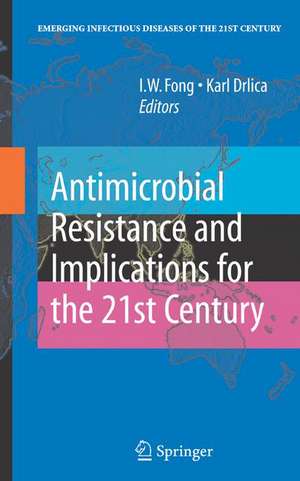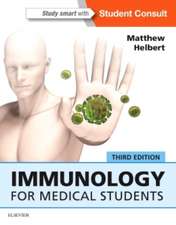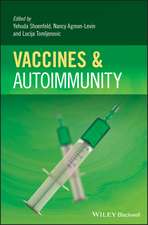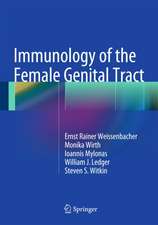Antimicrobial Resistance and Implications for the 21st Century: Emerging Infectious Diseases of the 21st Century
Editat de I.W. Fong, Karl Drlicaen Limba Engleză Hardback – 24 oct 2007
This comprehensive, up-to-date volume aims to define issues and potential solutions to the challenges of antimicrobial resistance. The chapter authors are leading international experts on antimicrobial resistance among a variety of bacteria (Streptococcus pneumoniae, enteroccoci, staphylococci, gram-negative bacilli, mycobacteria species) viruses (HIV, herpesviruses), and fungi (Candida species, fusarium etc.). The chapters will explore the molecular mechanisms of drug resistance, the immunology and epidemiology of resistance strains, clinical implications and implications on research and lack thereof, and prevention and future directions. This volume will also describe the steps that researchers are taking to develop molecular methods for detecting resistance; develop drugs and other means to deal with newly-resistant organisms. A special chapter to address the issues on strategies to limit antimicrobial resistance propagation will be included in this volume.
| Toate formatele și edițiile | Preț | Express |
|---|---|---|
| Paperback (1) | 1616.82 lei 38-45 zile | |
| Springer Us – 28 noi 2010 | 1616.82 lei 38-45 zile | |
| Hardback (1) | 1108.14 lei 6-8 săpt. | |
| Springer Us – 24 oct 2007 | 1108.14 lei 6-8 săpt. |
Din seria Emerging Infectious Diseases of the 21st Century
- 5%
 Preț: 1104.48 lei
Preț: 1104.48 lei - 18%
 Preț: 1836.82 lei
Preț: 1836.82 lei - 18%
 Preț: 1233.06 lei
Preț: 1233.06 lei - 5%
 Preț: 715.55 lei
Preț: 715.55 lei - 5%
 Preț: 1415.01 lei
Preț: 1415.01 lei - 15%
 Preț: 642.03 lei
Preț: 642.03 lei - 5%
 Preț: 1421.21 lei
Preț: 1421.21 lei - 5%
 Preț: 1101.21 lei
Preț: 1101.21 lei - 5%
 Preț: 1095.16 lei
Preț: 1095.16 lei - 5%
 Preț: 370.21 lei
Preț: 370.21 lei - 5%
 Preț: 1288.99 lei
Preț: 1288.99 lei - 5%
 Preț: 1318.25 lei
Preț: 1318.25 lei - 5%
 Preț: 1601.89 lei
Preț: 1601.89 lei - 5%
 Preț: 1162.44 lei
Preț: 1162.44 lei - 5%
 Preț: 717.37 lei
Preț: 717.37 lei
Preț: 1108.14 lei
Preț vechi: 1166.47 lei
-5% Nou
Puncte Express: 1662
Preț estimativ în valută:
212.07€ • 221.12$ • 176.25£
212.07€ • 221.12$ • 176.25£
Carte tipărită la comandă
Livrare economică 21 martie-04 aprilie
Preluare comenzi: 021 569.72.76
Specificații
ISBN-13: 9780387724171
ISBN-10: 0387724176
Pagini: 408
Ilustrații: XII, 408 p.
Dimensiuni: 156 x 235 x 24 mm
Greutate: 0.76 kg
Ediția:2008
Editura: Springer Us
Colecția Springer
Seria Emerging Infectious Diseases of the 21st Century
Locul publicării:New York, NY, United States
ISBN-10: 0387724176
Pagini: 408
Ilustrații: XII, 408 p.
Dimensiuni: 156 x 235 x 24 mm
Greutate: 0.76 kg
Ediția:2008
Editura: Springer Us
Colecția Springer
Seria Emerging Infectious Diseases of the 21st Century
Locul publicării:New York, NY, United States
Public țintă
ResearchCuprins
Mechanisms of Resistance by Gram-Positive Bacteria (Streptococci and Enterococci).- Emergence of MRSA in the Community.- Antimicrobial Resistance to Sexually Transmitted Infections.- Resistance of Gram-Negative Bacilli to Antimicrobials.- Mycobacterial Antimicrobial Resistance.- Antimicrobial Resistance of Anaerobic Bacteria.- Clinical Significance and Biological Basis of HIV Drug Resistance.- Resistance of Herpesviruses to Antiviral Agents.- Hepatitis Virus Resistance.- Resistance to Antifungal Agents.- An Anti-mutant Approach for Antimicrobial Use.
Textul de pe ultima copertă
This new volume of the Emerging Infectious Diseases of the 21st Century series is a collection of chapters by leading world authorities on antimicrobial resistance of common, important bacterial, viral and fungal pathogens. This unique book should be in the possession of anyone interested in the field of infectious diseases, microbiology, infection control & public health. The chapters, which are written by reknown experts, provide a wealth of contemporary information on microbiology, molecular mechanisms, epidemiology, clinical relevance, treatment, and prevention and future directions on the following topics:
- Mechanism of Resistance by Gram Positive Bacteria
- Emergence of MRSA in the Community
- Antimicrobial Resistance of STD pathogens
- Resistance of Gram Negative Bacilli to Antimicrobials
- Mycobacterial Antimicrobial Resistance
- Antimicrobial Resistance of Anaerobic Bacteria
- HIV Drug Resistance
- Resistance of Herpes viruses to Antiviral Agents
- Hepatitis Virus Resistance
- Resistance to Antifungal Agents
- An Anti-Mutant Approach for Antimicrobial Use
Caracteristici
A special chapter that addresses the issues on strategies to limit antimicrobial resistance propagation will be included in this volume Includes supplementary material: sn.pub/extras
Descriere
Descriere de la o altă ediție sau format:
Antimicrobial resistance can develop in any type of microbe (germ). Microbes can develop resistance to specific medicines. A common misconception is that a person’s body becomes resistant to specific drugs. However, it is microbes, not people that become resistant to the drugs. Drug resistance happens when microbes develop ways to survive the use of medicines meant to kill or weaken them. If a microbe is resistant to many drugs, treating the infections it causes can become difficult or even impossible. Someone with an infection that is resistant to a certain medicine can pass that resistant infection to another person. In this way, a hard-to-treat illness can be spread from person to person. In some cases, the illness can lead to serious disability or even death.
This comprehensive, up-to-date volume aims to define issues and potential solutions to the challenges of antimicrobial resistance. The chapter authors are leading international experts on antimicrobial resistance among a variety of bacteria (Streptococcus pneumoniae, enteroccoci, staphylococci, gram-negative bacilli, mycobacteria species) viruses (HIV, herpesviruses), and fungi (Candida species, fusarium etc.). The chapters will explore the molecular mechanisms of drug resistance, the immunology and epidemiology of resistance strains, clinical implications and implications on research and lack thereof, and prevention and future directions. This volume will also describe the steps that researchers are taking to develop molecular methods for detecting resistance; develop drugs and other means to deal with newly-resistant organisms. A special chapter to address the issues on strategies to limit antimicrobial resistance propagation will be included in this volume.
Antimicrobial resistance can develop in any type of microbe (germ). Microbes can develop resistance to specific medicines. A common misconception is that a person’s body becomes resistant to specific drugs. However, it is microbes, not people that become resistant to the drugs. Drug resistance happens when microbes develop ways to survive the use of medicines meant to kill or weaken them. If a microbe is resistant to many drugs, treating the infections it causes can become difficult or even impossible. Someone with an infection that is resistant to a certain medicine can pass that resistant infection to another person. In this way, a hard-to-treat illness can be spread from person to person. In some cases, the illness can lead to serious disability or even death.
This comprehensive, up-to-date volume aims to define issues and potential solutions to the challenges of antimicrobial resistance. The chapter authors are leading international experts on antimicrobial resistance among a variety of bacteria (Streptococcus pneumoniae, enteroccoci, staphylococci, gram-negative bacilli, mycobacteria species) viruses (HIV, herpesviruses), and fungi (Candida species, fusarium etc.). The chapters will explore the molecular mechanisms of drug resistance, the immunology and epidemiology of resistance strains, clinical implications and implications on research and lack thereof, and prevention and future directions. This volume will also describe the steps that researchers are taking to develop molecular methods for detecting resistance; develop drugs and other means to deal with newly-resistant organisms. A special chapter to address the issues on strategies to limit antimicrobial resistance propagation will be included in this volume.










